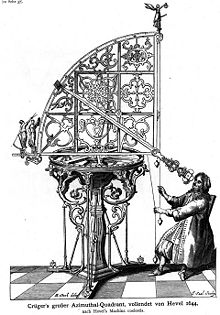Peter Crüger
Peter Crüger, also: Peter Krüger, Piotr Krüger (born October 20, 1580 in Königsberg , † June 6, 1639 in Danzig ) was a German philologist, astronomer and mathematician.
Life
Crüger was born the son of the Königsberg deacon Wilhelm Krüger († 1583) and his wife Dorothea (née Werner; † 1586), the daughter of Mayor Dringfort / Prussia Ambrosius Werner. After the early death of his parents, he came to his grandfather, who enabled him to go to school for the first time. In 1591 he continued his education at the school in Königsberg and became a choirboy there the following year. In 1597 he became a student at the University of Königsberg , where he was deposited on October 21, 1591. In 1603 he moved to the grammar school in Gdansk with two noblemen.
In the winter semester of 1605 he enrolled at the University of Leipzig , on September 15, 1606 at the University of Wittenberg, and on October 23, 1606 acquired the academic degree of a master's degree in philosophy. Although he wanted to complete an educational trip to France the following year, he accepted the appointment as high school professor of mathematics and poetry in Gdansk in the same year. Crüger was in contact with Tycho Brahe and Johannes Kepler , with whom he discussed research results. Among his students were Johannes Hevelius and Andreas Gryphius , whom he later strongly influenced. In Danzig he belonged to Martin Opitz's circle of poets . Crüger also designed various astronomical measuring instruments.
He wrote numerous writings on trigonometry , his Trigonometria appeared in 1612 and his Praxis trigonometriae logarithmicae in 1634 . His work in the field of astronomy includes De hypothetico systemate coeli , published in 1615 , Uranodromus cometicus , published in 1619, and Cupediae astrosophiae , published in 1630 .
He is also aware of the chronological work of a calendar for the year 1698, which was published under the title Diatribe paschalis, from the right Feyer time of the Jewish and Christian Easter celebrations . The crater Crüger is named after him.
family
Crüger was married twice. His first marriage was in 1608 with Elisabeth Reutorff († August 7, 1625 in Danzig), the daughter of † Hans Reutorff. The marriage resulted in three sons and two daughters. The sons all died young. One daughter who was married died in 1636. The other daughter was buried with him. After the death of his first wife, he entered into a second marriage with Ursula Remi, the daughter of the deacon Martin Remi in Gdansk. The marriage resulted in four sons and two daughters. A son and a daughter survived the father.
literature
- Moritz Cantor : Crüger, Peter . In: Allgemeine Deutsche Biographie (ADB). Volume 4, Duncker & Humblot, Leipzig 1876, p. 625.
- Friedrich Johann Buck : Biographies of the deceased mathematicians in general and of the great Prussian mathematician P. Christian Otters, who died more than a hundred years ago, credibly promoted to print, especially in two departments. Hartung & Zeise, Königsberg and Leipzig, 1764, p. 54 ( digitized version )
- Daniel Dilger : Christian corpse sermon Bey the funeral of the honorable and highly educated Mr. M. Petri Crügeri of the city of Dantzigk wolbestalten Mathematici. Dantzig, 1639, ( digitized version )
- Johann Christian Poggendorff : Biographical-literary concise dictionary for the history of the exact sciences. Johann Ambrosius Barth, Leipzig, 1863, vol. 1, p. 501 ( digitized version )
Individual evidence
- ↑ Georg Erler: The matriculation and doctoral registers of the Albertus University in Königsberg i. Pr. 1544-1829. Leipzig, 1910, p. 111
- ^ Georg Erler: The younger matriculation of the University of Leipzig, 1559-1809. Leipzig, 1909, vol. 1, p. 246
- ^ Bernhard Weissenborn: Album Academiae Vitebergensis, Younger Series, Part 1, (1602-1660). Magdeburg, 1934, p. 51, no. 496
- ↑ Machina coelestis , vol. 1, 1673, p.37
- ↑ Peter Crüger: Cupediæ Astrosophicæ [...] Therein the most artistic and deeply firm secret nuts / the Astronomiæ, the calendar writing / the Astrologiæ, and the Geographiæ [...] are stated. Baumann, Breslau 1631. Digitized and full text in the German text archive
Web links
| personal data | |
|---|---|
| SURNAME | Crüger, Peter |
| ALTERNATIVE NAMES | Krüger, Peter; Kruger, Piotr |
| BRIEF DESCRIPTION | German philologist, astronomer and mathematician |
| DATE OF BIRTH | October 20, 1580 |
| PLACE OF BIRTH | Koenigsberg |
| DATE OF DEATH | June 6, 1639 |
| Place of death | Danzig |
